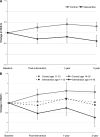Long-term maintenance of treatment outcomes: diabetes personal trainer intervention for youth with type 1 diabetes
- PMID: 19208916
- PMCID: PMC2671090
- DOI: 10.2337/dc08-1968
Long-term maintenance of treatment outcomes: diabetes personal trainer intervention for youth with type 1 diabetes
Abstract
Objective: To describe a 2-year follow-up of A1C outcomes of a self-regulation intervention for youth with type 1 diabetes.
Research design and methods: A total of 81 youths with type 1 diabetes ages 11-16 years were randomized to usual care versus a diabetes personal trainer intervention consisting of six self-monitoring, goal-setting, and problem-solving sessions with trained nonprofessionals. A1C data were obtained from medical records 2 years postintervention, and ANCOVA adjusting for age and baseline A1C was conducted.
Results: An overall intervention effect on A1C (8.93% control vs. 8.43% intervention; F = 8.24, P = 0.05) and a significant intervention-by-age interaction (F = 9.88; P = 0.002) were observed, indicating a greater effect among older than younger youths. Subgroup analyses demonstrated no treatment group differences among pre-/early adolescents but a significant difference in A1C among middle adolescents (9.61% control vs. 8.46% intervention; F = 7.20, P = 0.011).
Conclusions: Findings indicate maintenance of intervention effects on A1C observed at 1-year follow-up.
Figures
Similar articles
-
Diabetes personal trainer outcomes: short-term and 1-year outcomes of a diabetes personal trainer intervention among youth with type 1 diabetes.Diabetes Care. 2007 Oct;30(10):2471-7. doi: 10.2337/dc06-2621. Epub 2007 Jul 9. Diabetes Care. 2007. PMID: 17620445 Free PMC article. Clinical Trial.
-
Family-based psychoeducation and Care Ambassador intervention to improve glycemic control in youth with type 1 diabetes: a randomized trial.Pediatr Diabetes. 2014 Mar;15(2):142-50. doi: 10.1111/pedi.12065. Epub 2013 Aug 5. Pediatr Diabetes. 2014. PMID: 23914987 Free PMC article. Clinical Trial.
-
Assessment of a Precision Medicine Analysis of a Behavioral Counseling Strategy to Improve Adherence to Diabetes Self-management Among Youth: A Post Hoc Analysis of the FLEX Trial.JAMA Netw Open. 2019 May 3;2(5):e195137. doi: 10.1001/jamanetworkopen.2019.5137. JAMA Netw Open. 2019. PMID: 31150087 Free PMC article. Clinical Trial.
-
Do the effects of psychological treatments on improving glycemic control in type 1 diabetes persist over time? A long-term follow-up of a randomized controlled trial.Psychosom Med. 2012 Apr;74(3):319-23. doi: 10.1097/PSY.0b013e31824c181b. Epub 2012 Mar 20. Psychosom Med. 2012. PMID: 22434919 Clinical Trial.
-
The effect of nurse-led diabetes self-management education on glycosylated hemoglobin and cardiovascular risk factors: a meta-analysis.Diabetes Educ. 2012 Jan-Feb;38(1):108-23. doi: 10.1177/0145721711423978. Epub 2011 Nov 23. Diabetes Educ. 2012. PMID: 22116473 Review.
Cited by
-
Clinical Utility of Psychoeducational Interventions for Youth with Type 1 Diabetes: A Scoping Review.Contin Educ. 2021 Jul 15;2(1):76-108. doi: 10.5334/cie.28. eCollection 2021. Contin Educ. 2021. PMID: 38774890 Free PMC article.
-
Multisystemic therapy compared to telephone support for youth with poorly controlled diabetes: findings from a randomized controlled trial.Ann Behav Med. 2012 Oct;44(2):207-15. doi: 10.1007/s12160-012-9378-1. Ann Behav Med. 2012. PMID: 22644587 Free PMC article. Clinical Trial.
-
Reduction of hypoglycaemic events with a behavioural intervention: a randomized clinical trial for paediatric patients with Type 1 diabetes mellitus.Diabet Med. 2017 Mar;34(3):340-347. doi: 10.1111/dme.12744. Epub 2016 Nov 24. Diabet Med. 2017. PMID: 25763988 Free PMC article. Clinical Trial.
-
The search for effective behavioural approaches for adolescent type 1 diabetes management.Lancet Child Adolesc Health. 2018 Sep;2(9):622-623. doi: 10.1016/S2352-4642(18)30241-4. Epub 2018 Jul 31. Lancet Child Adolesc Health. 2018. PMID: 30119751 Free PMC article. No abstract available.
-
Psychosocial interventions for the diabetic patient.Diabetes Metab Syndr Obes. 2015 Jan 9;8:29-43. doi: 10.2147/DMSO.S44352. eCollection 2015. Diabetes Metab Syndr Obes. 2015. PMID: 25657590 Free PMC article. Review.
References
-
- Mortensen HB, Hougaard P: the Hvidøre Study Group on Childhood Diabetes. Comparison of metabolic control in a cross-sectional study of 2,873 children and adolescents with IDDM from 18 countries. Diabetes Care 1997; 20: 714– 720 - PubMed
-
- Brink SJ, Moltz K: The message of the DCCT for children and adolescents. Diabetes Spectrum 1997; 10: 259– 267
-
- Wysocki T, Hough BS, Ward KM, Green LB: Diabetes mellitus in the transition to adulthood: adjustment, self-care, and health status. J Dev Behav Pediatr 1992; 13: 194– 201 - PubMed
-
- Palmer DL, Berg C, Wiebe DJ, Beveridge RM, Korbel CD, Upchurch R, Swinyard MT, Lindsay R, Donaldson DL: The role of autonomy and pubertal status in understanding age differences in maternal involvement in diabetes responsibility across adolescence. J Pediatr Psychol 2004; 29: 35– 46 - PubMed
Publication types
MeSH terms
Substances
Grants and funding
LinkOut - more resources
Full Text Sources
Medical


